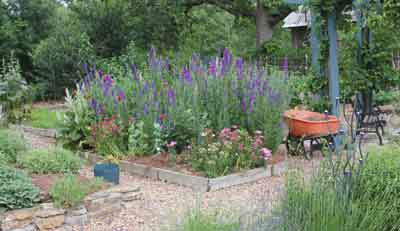Copyright 2013, Jim Long
No reproduction or reposting of this material is allowed without permission of the author.
 |
| Black swallowtail caterpillar, eating one leaf of fennel. |
 |
| Black Swallowtail on Butterfly Weed (Asclepias tuberosa) |
This is a re-posting of what I wrote about black swallowtail butterflies in 2010 and it's timely today because these colorful caterpillars are appearing in the garden this week.
Butterflies look so slow and docile, gently flitting about the garden.
Just get our your camera and try to catch them in their daily duties of
sipping nectar out of flowers; you'll quickly see they are shy, move
fast and don't like being photographed.
I doubt their eyesight is so great they can see me, but maybe they can. I
guess if you're an inch tall and a looming giant, 500 times bigger than
you are and carrying a menacing black box with a big moving eye-lens,
you might run, too.
 |
| Weak, tired and with much of her color worn down, she drank nectar for a day before laying eggs. |
Maybe they simply sense a person following them in the garden. After
all, their senses must be impeccable, or else they couldn't travel great
distances. This Monarch butterfly, above, on the white flowered chives,
showed up just as the chives were blooming. As you know, Monarchs spend
their winter in South America and manage to navigate northward as the
weather warms in spring. This one was worn to a frazzle, weak, but
sipping nectar in order to regain her strength for laying eggs for
another generation of Monarchs.
 |
| A Tiger Swallowtail, dishing up breakfast from dianthus in my edible flower garden. |
Most people seem to like butterflies, but many of those
same folks have no hesitation for stomping caterpillars. This time of
year you'll notice what we always called "dill worms" when I was growing
up.
 |
| The caterpillar of the Black Swallowtail Butterfly on a fennel leaf. |
Black Swallowtail butterflies lay eggs on: fennel, dill,
parsley and related plants. Those hatch into the caterpillar you see
above. The caterpillar hangs around on one leaf and eats most of it,
then pupates, building a little cocoon around itself and hanging there
in a little hammock until it has grown. The cocoon splits and out comes
the adult Black Swallowtail.
 |
| The majestic Black Swallowtail, newly hatched. |
 |
| An older Black Swallowtail, on oregano. |
|
The list of herbs that attract butterflies is long and
extensive. A few you might want to plant if you wish to attract
butterflies: Mint, oregano, butterfly weed, Mexican butterfly weed, rue,
dill, fennel, parsley, sage, rosemary, thyme, lemon balm, roses, sweet
marjoram, hyssop, chives, monarda, yarrow - the list really is quite
long.
 |
| Monarch caterpillar, see how different they look from the Swallowtail caterpillar? |
Monarch caterpillars, however, hang out, sip nectar and
lay eggs on butterfly weed (Asclepias tuberosa) which is in bloom right
at the time Monarchs are looking for food and home. In case you don't
recognize butterfly weed, here's a picture, below. Note that lots of
butterflies like the nectar from this plant but it's the Monarch that
likes to hang its hat there.
 |
| Fritillary butterflies on butterfly weed. |
Here in the Ozarks, the butterfly weed is a common
roadside plant, starting its bloom around the end of May. This is an
old-time medicinal plant, sometimes called, "pleurisy root" because of
its use in treating that ailment.
So, if you see, "worms" in your herb plants, let them be, they turn into
butterflies or moths and they're not going to ruin your plants. You'll
be glad you left them alone when they turn into butterflies! And if
you're going to photograph them, well, give yourself more time than you
think you will need, they can run faster than you can.




























